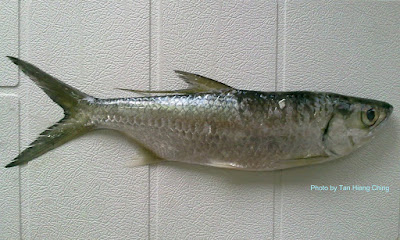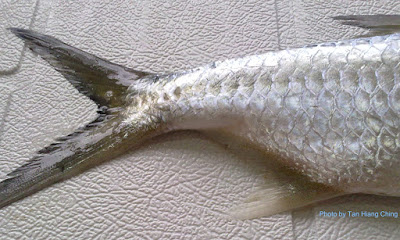Tarpons
Tarpons are the members of the Megalopidae family. They have moderately deep body, large eye, projecting lower jaw and large scales. Their fins lack spines, dorsal fin origin at about midpoint of body, last dorsal fin ray filamentous and anal fin origin a little behind dorsal fin base. Their back is blue or green in colour and their flanks silvery.
Tarpons are found in most tropical and subtropical waters around the world. They are primarily coastal fishes, commonly entering lagoons and estuaries. They spawn offshore and young larvae are found in the open sea. Juveniles move inshore and often occur in tidal streams, mangrove swamps and lakes. They can tolerate a wide range of salinity and pH. Their modified swim bladder can be filled directly with air and permits the fish to live in oxygen-poor waters. Tarpons are diurnal predator fishes, feeding mainly on fishes and crustaceans. They are also active swimmers. They are regarded as one of the most exciting gamefish. As soon as the hook is set, a tarpon will perform a series of twisting leaps to try to itself.
There is only one genus and 2 species of Megalopidae worldwide. Megalops atlanticus, the larger species grows up to 250 cm total length and more than 160 Kg in weight. The other species, Megalops cyprinoides grows up to 150 cm and 18 Kg in weight. Megalops cyprinoides are distinguished by having their caudal peduncle end with double V shape and lighter colour anal fin.
Tarpons are found in most tropical and subtropical waters around the world. They are primarily coastal fishes, commonly entering lagoons and estuaries. They spawn offshore and young larvae are found in the open sea. Juveniles move inshore and often occur in tidal streams, mangrove swamps and lakes. They can tolerate a wide range of salinity and pH. Their modified swim bladder can be filled directly with air and permits the fish to live in oxygen-poor waters. Tarpons are diurnal predator fishes, feeding mainly on fishes and crustaceans. They are also active swimmers. They are regarded as one of the most exciting gamefish. As soon as the hook is set, a tarpon will perform a series of twisting leaps to try to itself.
There is only one genus and 2 species of Megalopidae worldwide. Megalops atlanticus, the larger species grows up to 250 cm total length and more than 160 Kg in weight. The other species, Megalops cyprinoides grows up to 150 cm and 18 Kg in weight. Megalops cyprinoides are distinguished by having their caudal peduncle end with double V shape and lighter colour anal fin.
Scientific Name: Megalops cyprinoides (Broussonet, 1782)
English Name: Indo-Pacific Tarpon, Oxeye Tarpon
French Name: Tarpon indo-pacifique
Chinese Name | 鱼类中文名: 大眼海鲢 (Dà yǎn hǎi lián), 大海鰱 (Dà hǎi lián), 海庵 (Hǎi ān)
Malay Name | Nama Melayu Malaysia: Ikan Bulan, Bulan-bulan
Thai Name | ชื่อสามัญภาษาไทย: ปลาตาเหลือกสั้น (Plā tāh̄elụ̄xk s̄ận)
Main Identification Features: Elongated dorsal fin ray. Caudal peduncle end with double V shape and lighter colour anal fin.
Size: Maximum 150 cm and 18 Kg in weight.
Habitat and Ecology: Coastal and estuarine waters, to 50 m depth. Adults are generally found at sea. They spawn offshore and young larvae are found in the open sea. Juveniles are found inshore and in estuaries. Feed mainly on fishes and crustaceans.



English Name: Indo-Pacific Tarpon, Oxeye Tarpon
French Name: Tarpon indo-pacifique
Chinese Name | 鱼类中文名: 大眼海鲢 (Dà yǎn hǎi lián), 大海鰱 (Dà hǎi lián), 海庵 (Hǎi ān)
Malay Name | Nama Melayu Malaysia: Ikan Bulan, Bulan-bulan
Thai Name | ชื่อสามัญภาษาไทย: ปลาตาเหลือกสั้น (Plā tāh̄elụ̄xk s̄ận)
Main Identification Features: Elongated dorsal fin ray. Caudal peduncle end with double V shape and lighter colour anal fin.
Size: Maximum 150 cm and 18 Kg in weight.
Habitat and Ecology: Coastal and estuarine waters, to 50 m depth. Adults are generally found at sea. They spawn offshore and young larvae are found in the open sea. Juveniles are found inshore and in estuaries. Feed mainly on fishes and crustaceans.


